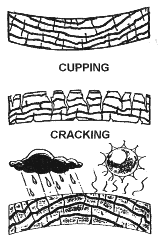
"We're the deck people"TM

About Wood
Wood is the preferred material for decks. Not only is wood beautiful, it is also stable, durable, and easy to work with. Wood is susceptible, however, to water damage and should be checked regularly. Boards that are split, cracked, or have raised nails indicate a possible problem with moisture penetration. Wood is also a porous material, like skin; and like skin, wood pores can become clogged and deteriorate. One way to prevent problems with your wood is to have it sealed and maintained. Below is a list of commonly used woods for deck construction.
Types of Wood Cedar: The wood from this large, coniferous evergreen tree is a popular favorite for decks. It not only looks and smells wonderful, it is also extremely durable. The texture of cedar is soft, and the grain of cedar is intricate and beautiful. Cedar produces natural tannins that are thought to be naturally resistant to insects. These tannins, however, can spot, especially after rainfalls, and this continues until the wood becomes fully acclimatized (about three years). Sealer colors that work particularly well with cedar are the natural redwood or cedar tinted, or clear. These sealers allow the natural grain of the wood to show through, while at the same time protecting the wood through a color tint. Redwood: Used frequently in timber construction, redwood is (as the name suggests) a reddish wood. Outside of the color, redwood is very similar to cedar. Pressure- Treated Pine: This term refers to wood that has been chemically treated to ward off insects and rot. Cedar and redwood are never treated. The drawbacks to using pressure treated wood are rapid discoloration, prone to splitting, and many chemicals are in the wood that can discolor it. As with all woods, it is always best to have your pressure treated wood seasoned, cleaned, and sealed so that these natural drawbacks can be avoided. Pine: This long-needled tree also has wood that is very popular in deck construction. Pine varies from very soft wood, as with the white pine, to very hard wood, as in the long leaf pine. Usually pressure treated for deck construction, pine is very versatile, cheaper than cedar or redwood, and dependable. Depending on personal preference, pine works well with any color sealer. As with cedar, there are natural colors that can enhance the natural grain and color of the wood. RECONSTITUTED WOOD PRODUCTS Hardboard, a relatively heavy type of fiberboard, is a popular siding product. Continuous film coatings are recommended on this substrate, not stains. However, water soluble extractives in the product may leach through paints causing a discoloration. Acrylic latex stain blocking primers and one or two acrylic latex topcoats are recommended. Pre-primed hardboard must be primed again on-site before top coating. Storage of the product under fluctuating moisture conditions will cause a dislodging of the surface fibers (the primer cannot inhibit this) resulting in an unstable surface. Re-priming will help stabilize the surface and will help in avoiding early paint failure. Other reconstituted products, including waferboard, strandboard. (OSB) and flakeboard, are difficult to coat successfully unless the surfaces are treated or overlaid specifically for exterior usage. In this case continuous film coatings are usually recommended. CEDAR AND REDWOOD SIDING Water soluble extractives are present in cedar and redwood, and may leach through coatings as they become activated by moisture. These may show up as tobacco colored stains, particularly on light colored stains or paints. They may be controlled with rather good success by using an acrylic latex stain blocking primer or an exterior oil based primer before painting, but may cause discoloration on light colored semi-penetrating or solid color stains. PORCH AND DECKING PLYWOOD PRODUCTS ALUMINUM AND VINYL SIDING WOOD SHAKES AND SHINGLES WOOD CHARACTERISTICS AFFECTING COATABILITY Coatings fall into two categories. Continuous film coatings are primers, paints, heavy bodied and solid color stains which form a solid, unbroken film over the surface. Semi-penetrating stains, the second category, penetrate the surface of the wood to a great extent resulting in very little surface film. Wood products may be success-fully coated by one, or both, or neither of these coating types, de-pending on their characteristics and how they are manufactured. Wood species are characterized by their density (weight), presence of early wood or latewood, their texture (cell structure) and the extent of extractives including water soluble color, pitch and oil. Generally, higher density woods (hardwoods) are less suitable for exterior use than less dense softwoods such as cedar and redwood. Manufacturing and grading of wood products also determine their suitability for accepting coatings. Surface textures, knots or other defects, and moisture content greatly affect coatability. How the product is cut from the log, to yield edge grain or flat grain boards, often dictates what type of coating can be used successfully on the product. Most standard lumber grades contain a high percentage of flat grain, whereas premium grades are predominantly edge grain. Flat grain areas tend to swell and shrink more, are relatively unstable, and will not hold continuous film coatings nearly as well as the more stable edge grain surfaces.
|